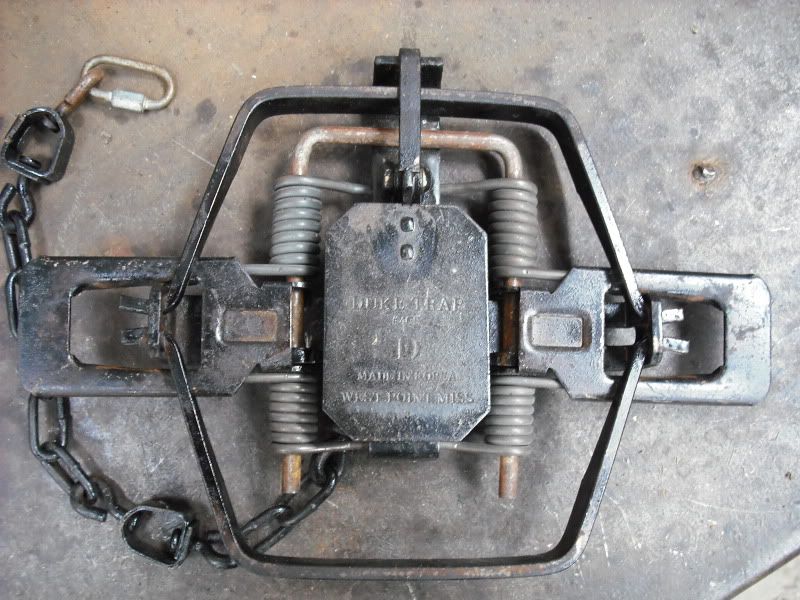|
|
Post by trappincoyotes39 on Mar 11, 2011 14:31:59 GMT -6
I have never had issues with the milligan helper springs bending anything and even with 9ga wire laminations they come up and hold very well.
I have some that came with the bridger helpers same thing No issues with spring pins bending on any of those bridger 3's I have.
To me it is a design flaw if one needs to make larger spring pins to make a trap "work". The company should fix the problem, not having to modify the basic parts of a trap.
|
|
|
|
Post by seldom on Mar 11, 2011 15:23:45 GMT -6
Yes TC, I have a tendency to agree with you but I also understand that in a lot of industries very little attention is given to material specs. Even if the rod used had an ASTM spec, there can be as high as a 14% variance in chemical composition. It's been my experience that even in industries far more critical then trap making many folks go to cheap and/or whatever the supplier sends them.
It appears to me that the folks building Bridgers at the time mine were built were supplied with a very low carbon rod meaning it's just plain softer then it should be in order to not deflect when you add the appropriate helper springs to the pins!
Apparently it isn't only Bridgers that have had this problem occur. I was at a trap modifier's website recently and while looking though examples of his work, saw some several different traps with his rendition of spring pins supports attached.
|
|
|
|
Post by nightstalker1 on Mar 11, 2011 16:01:26 GMT -6
I like to add a spring pin support on 4-coil traps just for that little added support. Simple and quick. You can still remove the spring pin if you have to change springs or break the trap down for any reason. On some occasions, I have tacked the pins to the support   |
|
|
|
Post by seldom on Mar 11, 2011 16:23:10 GMT -6
My clips look like this one that's on a #2 Bridger. Some they're drilled to accept the end of the spring pins, there's only one tack to the end of the cross frame and they work very well. I do like the idea of the larger diameter spring pin though mainly because you should be able to take any slop out of the holes and help ensure a flatter, loose jaw.  |
|
|
|
Post by CoonDuke on Mar 11, 2011 16:28:39 GMT -6
Here are the traps I like for beaver, #3 music mains and #1.5 music helpers. These are crazy strong...almost scary.   No stock spring pin will hold up to this power, and the loose jaw will ride high...Duke or Bridger. The big spring pin solves a lot of headaches. I would not be afraid to use a trap with stock mains and #1.5 music helpers for coyotes. I don't like changing springs so tend to overspring and let them weaken to the point I like them. |
|
|
|
Post by seldom on Mar 11, 2011 17:07:36 GMT -6
|
|
|
|
Post by CoonDuke on Mar 11, 2011 18:46:08 GMT -6
If anyone wants these pins Rich Kaspar made a bunch for me. I made some myself but found out it is a lot easier to pay Rich to do it and spend time with my family instead of bending pins.
|
|
|
|
Post by trappincoyotes39 on Mar 11, 2011 19:02:06 GMT -6
I have no doubts coon duke with what you said about the jaw riding higher, my point is I do not need ALL that power for coyotes, too much can lead to foot issues as well.
AS far as beaver unless mandated by law I want a larger jaw spread for them anyhow than a #3 bridger. If you want max power for beaver the CDR"s are tough to beat plus they have a nice jaw spread as well.
|
|
|
|
Post by CoonDuke on Mar 11, 2011 19:17:39 GMT -6
Agree with that TC.
PA is a state that only allows a 6.5" trap for beaver. I think we could get this changed but the PA trappers need to push for it. There are some that resist any form of change, and try to strangle any progress that others try to make.
I trap PA with footholds and use them a lot in the south too. You can bet when I am allowed to I am using a 7.5" trap. The difference in efficiency between these two sized traps is huge and anyone that says different is either unobservant or just doesn't put that many beaver in foot traps. IMO, pan tension can make you or break you with beaver traps too.
As far as your spring power goes for coyotes, I have no doubts that what you use works well in your conditions. Soil conditions and weather play into it a bit too.
|
|
|
|
Post by trappnman on Mar 12, 2011 8:02:20 GMT -6
You can bet when I am allowed to I am using a 7.5" trap. The difference in efficiency between these two sized traps is huge and anyone that says different is either unobservant or just doesn't put that many beaver in foot traps.
or, doesn't set for front foot catches.
I cannot remember the last time I had either a rear foot catch, or a snapped traps using #4 dlps. Not going to get into methods, but suffice it to say that if you are making sets where that beaver is walking into the trap, you don't need huge jawspreads.
not everyone sets deep, for back foot catches. If doing so, with less precise foot placement that setting deep entails, then sure, bigger the better.
If its deep water I set 330s- if its shallower water for footholds, I set for front foot catches for 2 reasons- one, you CAN use a smaller trap, and more importantly, front foot catches take half the needed water to drown- a factor on smaller streams
|
|
|
|
Post by thorsmightyhammer on Mar 12, 2011 9:10:02 GMT -6
My foothold of choice is a number 5 bridger or duke.
I set almost exclusively for front foot.
I have friends that almost exclusively front foot and they are using mb750's.
I threw out the 4's along time ago.
You lay out a string of 50 or 60 and their weaknesses start to show.
|
|
|
|
Post by trappnman on Mar 12, 2011 9:26:21 GMT -6
not going to argue with you which trap you like better or what your friends think is better- none of that changes what's true for me, and my style of sets.
I know what the #4s do for me- doesn't matter if I'm setting 20 or 100- setting 15-20 year after year, including all ADC work, shows me what they do with my style of use. Putting traps behind a ridge, in narrow entrances, puts the foot in the middle of the pan- whats to go wrong where a trap 1' bigger would cure?
I've got Duke #5s dls to use- worked great- but no different than the 4s for me- thus the extra work of having to use a setter, makes me leave them at home.
not saying its everyones way, but its my way, and its quite successful while not taking 1000s of beaver- getting the ones I target is all that matters to me.
if it takes me 5 minutes more to make the set, so be it.
|
|
|
|
Post by thebeav2 on Mar 12, 2011 10:00:34 GMT -6
The reason for this forum Is It's to be used as a teaching aid to trappers.
The MOST efficient way to catch beaver Is to use ALL the tools available to you the trapper and all the methods at his disposal. Using just one method or one type of trap In my opinion Is not going to get the job done.
I also don't like to be trap poor and what I mean by this Is I don't want to have 7 different traps hanging In my shed to do the same work that 1 or 2 types could do.
For example on beaver trapping Most of my beaver traps are 330 body grips. If I'm targeting a front foot or a hind foot then I want the biggest trap I can find. So all my beaver traps are MB750s It makes no difference If I'm targeting a front foot or a hind foot It's going to do the job for me.
Why would I want a bunch of 2s or threes or even 4s for front foot targeting? Because If I need to target a hind foot all the before mentioned traps are less then desirable. And let me tell you there will be situations where a one dimentional set Isn't going to get the job done.
Get the BEST trap for all situations learn differnt methods and you will be succsefull.
|
|
|
|
Post by thebeav2 on Mar 12, 2011 10:06:10 GMT -6
And Tman this Isn't directed toward you It's just the way It Is In the real world. If you wear a size 44 shirt and a size 3 hat and you run with me for 2 months you will be a world class beaver trapper or crippled for life. Then you need to take beaver trapping lessons from Robert to smooth off the rough spots.  |
|
|
|
Post by trappnman on Mar 12, 2011 10:23:41 GMT -6
yes, this is a teaching forum- and not a one size fits all forum. I agree. which is why I'm telling how I use #4dls on beaver. Am I saying that if all beaver traps in the world went out of production, and just one brand and size, deemed the "worlds best", was the only one still made and sold, that it would be a #4 dls? no- and I'm sure that for someone running 100 beaver traps for weeks and months, would benefit from the beggest trap he could use, simply becasue running a full blown beaver line, would necesitate having a 1 trap fits all situation and its run and gun. but thats not the point of my posts- My remarks were directed to CDs comment that anyone using a smaller trap than he preferred, either was unobservant, or hadn't caught many beavers. and I disagreed. I'm not unobservant, quite the opposite in fact, and while not having caught 1000s and 1000s of beaver, I have caught 500+ beaver over the years- for quite a few years, its under 15 a year- but thats because I encounter only that many. perferring trap A over Trap B, doesn;t translate into having a doz kinds of traps, and having to ponder.......... Is it a chore, as implied, to set for front feet only? Why? on smaller creeks, its almost impossible to not find multiple front foot situations- and almost as impossible to find water deep enough, at footholds locations, TO target a back foot. most trappers- and thats about all of them in the real world- that trap beaver, do so in small portions, trapping a handful a year. If those trappers can learn how to use smaller (#4 and #4s for beaver successfully, then its learning process. and its not rocket science, nor any more time consuming, to set a #4 for beaver, and have the same success as any other beaver trap. as far as "learn different sets and methods"- Rally takes almost 100% of his beaver the same set, and Bogmaster takes almost 100% of his beaver with his same set. ask either to use the others method- and both will laugh at you saying why change what works? I make the "same" beaver set every time- the structure at the location, makes every set unique. after all, why go through a mental catalog of 100 sets, trying to find the best, wandering up and down the banks trying to determine this set or that...............  and I use the same trap- you use a different one- each for their own reasons. you use and swear by #2 for mink, from your own conclusions and reasons- I think thats wrong- I'd never use #2 coils as my go to mink trap- I know my catch would be less- but would i tell you you are wrong, cause you don't smoke the same ciggarate......ops set a trap the same as me? no- cause a trap is a tool- one of the best quotes ever, from Bogmaster- "if you have one tool to use, you learn how to use that tool" no absolutes. |
|
|
|
Post by trappnman on Mar 12, 2011 10:27:48 GMT -6
with ADC work over past 3 years, I've set for 41 beaver-
I've caught, 41 beaver.
Real world enough for me.
I kinda think, as a SWAG, that if there would have been 42 I was setting for, I'd have taken 42
some taken in 330s, most in #4.
|
|
|
|
Post by thebeav2 on Mar 12, 2011 11:25:21 GMT -6
For those that are following these treads just look at the big picture. Learn to use different methods and match the traps to those methods and you will be successful . But don't become one dimensional.
|
|
|
|
Post by trappnman on Mar 12, 2011 11:30:42 GMT -6
I agree 100%- and you have made my point very well- match the set to the trap.
|
|
|
|
Post by thorsmightyhammer on Mar 12, 2011 11:40:00 GMT -6
500 beaver in 15 years wont give the same observations as 500 beaver in one year.
if it takes me 5 minutes more to make the set, so be it.
If it takes 5 minutes to set or reset 30 to 50 that is 2 to 3 hours extra a day.
|
|
|
|
Post by trappnman on Mar 12, 2011 11:46:55 GMT -6
yes, agreed- but time in setting is a different aspect than the effceintcy of a set once made
of course, one would have different observations on many things, just as one will have different observations on run and gun vs long term on lines, but 500 beaver trapped will certainly give reliable observations on trap success rates.
|
|